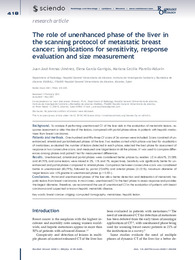Please use this identifier to cite or link to this item:
https://hdl.handle.net/11000/34675Full metadata record
| DC Field | Value | Language |
|---|---|---|
| dc.contributor.author | Arenas Jiménez, Juan José | - |
| dc.contributor.author | García Garrigós, Elena | - |
| dc.contributor.author | Planells-Alduvin, Mariana Cecilia | - |
| dc.contributor.other | Departamentos de la UMH::Patología y Cirugía | es_ES |
| dc.date.accessioned | 2025-01-16T18:31:55Z | - |
| dc.date.available | 2025-01-16T18:31:55Z | - |
| dc.date.created | 2021 | - |
| dc.identifier.citation | Radiology and Oncology. 2021 Nov 19;55(4):418-425 | es_ES |
| dc.identifier.issn | 1581-3207 | - |
| dc.identifier.issn | 1318-2099 | - |
| dc.identifier.uri | https://hdl.handle.net/11000/34675 | - |
| dc.description.abstract | Background: To analyse if performing unenhanced CT of the liver aids in the evaluation of metastatic lesions, response assessment or alter the size of the lesions, compared with portal phase alone, in patients with hepatic metastases from breast carcinoma. Patients and methods: One-hundred and fifty-three CT scans of 36 women were included. Scans consisted of unenhanced, arterial and portal delayed phases of the liver. Two readers sorted which phase was best for visualization of metastases, evaluated the number of lesions detected in each phase, selected the best phase for assessment of response in two consecutive scans, and measured one target lesion in all the phases. Χ2 was used to compare differences among phases and paired t test for measurement differences. Results: Unenhanced, arterial and portal phases were considered better phases by readers 1/2 in 68/67%, 27/28% and 69/70%, and some lesions were missed in 2%, 11% and 7%, respectively. Sensitivity was significantly better for unenhanced and portal phases compared to arterial phase. Comparison between consecutive scans was considered better in unenhanced (80/79%), followed by portal (70/69%) and arterial phases (31/31%). Maximum diameter of target lesions was 15% greater in unenhanced phase (p < 0.001). Conclusions: Portal and unenhanced phases of the liver allow better detection and delineation of metastatic hepatic lesions from breast carcinoma. In most cases, unenhanced CT is the best phase to assess response and provides the largest diameter. Therefore, we recommend the use of unenhanced CT in the evaluation of patients with breast carcinoma and suspected or known hepatic metastatic disease. | es_ES |
| dc.format | application/pdf | es_ES |
| dc.format.extent | 8 | es_ES |
| dc.language.iso | eng | es_ES |
| dc.publisher | Sciendo | es_ES |
| dc.rights | info:eu-repo/semantics/openAccess | es_ES |
| dc.rights | Attribution-NonCommercial-NoDerivatives 4.0 Internacional | * |
| dc.rights.uri | http://creativecommons.org/licenses/by-nc-nd/4.0/ | * |
| dc.subject | breast cancer | es_ES |
| dc.subject | staging | es_ES |
| dc.subject | computed tomography | es_ES |
| dc.subject | metastases | es_ES |
| dc.subject | hepatic lesion | es_ES |
| dc.title | The role of unenhanced phase of the liver in the scanning protocol of metastatic breast cancer: implications for sensitivity, response evaluation and size measurement | es_ES |
| dc.type | info:eu-repo/semantics/article | es_ES |
| dc.relation.publisherversion | 10.2478/raon-2021-0029 | es_ES |

View/Open:
The role of unenhanced phase of the liver in the scanning protocol of metastatic breast cancer. Implications for sensitivity, response evaluation and size measurement.pdf
1,03 MB
Adobe PDF
Share:
.png)
